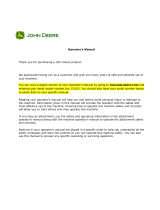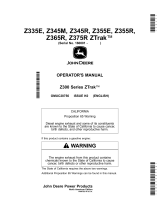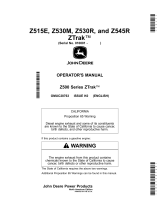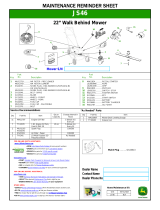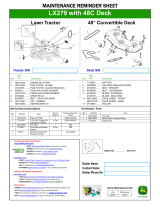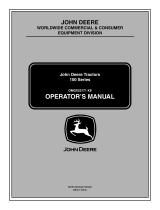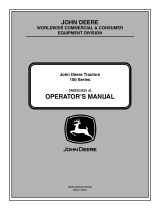Page is loading ...

S100, S110, S120, S130, S140, S160,
S170, and S180 Tractors
(Serial No. 010001- -XXXXXX)
OPERATOR'S MANUAL
100 Series Lawn Tractors
OMUC22642 ISSUE H0 (ENGLISH)
*OMUC22642*
CALIFORNIA
Proposition 65 Warning
Diesel engine exhaust and some of its constituents
are known to the State of California to cause cancer,
birth defects, and other reproductive harm.
If this product contains a gasoline engine:
WARNING
The engine exhaust from this product contains
chemicals known to the State of California to cause
cancer, birth defects or other reproductive harm.
The State of California requires the above two warnings.
Additional Proposition 65 Warnings can be found in this manual.
John Deere Power Products
North American Edition
PRINTED IN U.S.A.
*SELF**omuc22642*

Thank You for Purchasing a John Deere Product
We appreciate having you as a customer and wish you many years of
safe and satised use of your machine.
MX00654,000020B-19-10MAY17
Using Your Operator’s Manual
Read this operator’s manual, watch the safety video, and review the
safety signs on your machine before use. They all contain important
safety information and operating instructions that must be followed to
help keep you and others safe. Be sure everyone who uses the
machine has read the manual, reviewed the safety signs, and knows
how to use the machine safely and properly.
Your machine was designed and built to be operated in accordance
with all the safe operating instructions. Since it was designed to cut
grass, it can amputate hands and feet and throw objects. If you do not
follow safety instructions, serious injury or death can occur.
This operator manual is organized in sections to help you nd
information quickly. You can use this manual to nd answers to many
of your operating and servicing questions. An index at the end of this
book helps you nd needed information quickly. Contact your dealer if
this manual does not answer your questions.
Before using your machine:
● Know how to operate the machine. The Operating Controls section
helps you understand the controls of your machine and what they
do.
● Prepare your machine and the mowing area by performing required
daily checks outlined in the General Instructions section.
● Follow instructions in the Preventing Injuries section, especially
related to:
- Keeping children safe by following instructions in the Protect
Children section.
- Avoiding injury on slopes and near terrain hazards by following
instructions in the Operating on Slopes and Near Terrain
Hazards section.
- Follow the instructions in the Avoid Thrown Objects section and
keep all guards in place, including discharge chute.
- Cleaning machine during use and before storing as outlined in
the Prevent Fires section.
● Understand how to service and inspect your machine.
If you do not understand the instructions or have questions, contact
your dealer.
The machine shown in this manual can dier slightly from your
machine.
RIGHT-HAND and LEFT-HAND sides are determined by facing in the
direction that the machine travels when going forward. When you see
a broken line (------), the item referenced is hidden from view.
Before delivering this machine, your dealer performed a predelivery
inspection to ensure best performance.
This manual is an important part of your machine. Keep this manual
with the machine when you sell it.
OUO2005,000078D-19-11FEB20
Special Messages
Your manual contains special messages to bring attention to potential
safety concerns and machine damage, as well as helpful operating
and servicing information. Please read all the information carefully to
avoid injury and machine damage.
CAUTION: Avoid injury! This symbol and text highlight
potential hazards or death to the operator or bystanders
that may occur if the hazards or procedures are ignored.
IMPORTANT: Avoid damage! This text is used to tell the operator
of actions or conditions that might result in damage to the
machine.
NOTE: General information is given throughout the manual that may
help the operator in the operation or service of the machine.
MX00654,000020D-19-05JUN17
Parts
We recommend John Deere quality parts and lubricants, available at
your John Deere dealer.
When you order parts, your John Deere dealer needs the serial
number or product identication number (PIN) for your machine or
attachment. These are the numbers that you recorded in the Product
Identication section of this manual.
Order Service Parts Online
Visit http://JDParts.deere.com for your Internet connection to parts
ordering and information.
TC00531,00000E9-19-06MAR15
Service Literature
If you would like to purchase a copy of the Parts Catalog or Technical
Manual for this machine, visit The John Deere Technical Information
Store at:
https://techpubs.deere.com/
or call:
● U.S. & Canada: 1-800-522-7448.
● All Other Regions: Your John Deere dealer.
TH84124,0000199-19-05FEB20
Spark Arrestor
The California Public Resources Code, Section 4442.5 provides as
follows:
No person shall sell, oer for sale, lease, or rent to any person any
internal combustion engine subject to Section 4442 or 4443, and not
subject to Section 13005 of the Health and Safety Code, unless the
person provides a written notice to the purchaser or bailee, at the time
of sale or at the time of entering into the lease or rental contract,
stating that it is a violation of Section 4442 or 4443 to use or operate
the engine on any forest-covered, brush-covered, or grass-covered
land unless the engine is equipped with a spark arrestor, as dened in
Section 4442, maintained in eective working order or the engine is
constructed, equipped, and maintained for the prevention of re
pursuant to Section 4443. Cal. Pub. Res. Code 4442.5. Other states or
jurisdictions may have similar laws. A spark arrestor for your machine
may be available from your authorized dealer. An installed spark
arrestor must be maintained in good working order by the operator.
OUO2005,00006F6-19-19MAY19
Introduction
2

CCoonntteennttss
Introduction............ . . ........ . ........ . . ....... . . ........ . . 2
Product Identication.. . ........ . ........ . . ....... . . ........ . . 3
Safety Labels with Text.. . . ....... . . ........ . ........ . . ...... 5
Safety Labels without Text.... . ........ . . ....... . . ........ . . 8
Safety..... . . ....... . . ........ . . ....... . . ........ . ........ . . ... 10
Machine Cleanout.. . . ........ . ........ . . ....... . . ........ . .. 14
Operating Controls... . . ........ . ........ . . ....... . . ........ . 16
Operating... . . ....... . . ........ . ........ . . ....... . . ........ . .. 17
Service Intervals.... . . ........ . ........ . . ....... . . ........ . .. 28
Service Lubrication.. . ........ . ........ . . ....... . . ........ . .. 28
Service Engine.. . ........ . . ....... . . ........ . ........ . . ..... 29
Service Transmission........ . ........ . . ....... . . ........ . .. 35
Service Mower... . ........ . . ....... . . ........ . ........ . . ..... 35
Service Electrical....... . . ....... . . ........ . . ....... . . ....... 40
Service Miscellaneous... . . ....... . . ........ . ........ . . ..... 42
Troubleshooting..... . . ........ . ........ . . ....... . . ........ . .. 46
Storage. . . ........ . ......... . ....... . . ........ . .......... ..... 48
Specications..... . . ........ . . ....... . . ........ . ........ . . ... 48
Warranty........ . ........ . . ....... . . ........ . . ....... . . ....... 50
John Deere Quality Statement.. . ........ . . ....... . . ....... 54
Service Record.. . ........ . . ....... . . ........ . ........ . . ..... 55
Slope Gauge. ....... . . ........ . ........ . . ....... . . ........ . .. 56
Index........ . . ....... . . ........ . ........ . . ....... . . ........ . .. 57
Product Identication
Record Identication Numbers
Lawn Tractors
S100, S110, S120, S130, S140, S160, S170, S180
PIN (010001—)
If you need to contact an authorized service center for information on
servicing, always provide the product model and identication
numbers.
You need to locate the product identication number (PIN) for the
machine and engine serial number. Record the information in the
following spaces:
DATE OF PURCHASE:
_________________________________________
DEALER NAME:
_________________________________________
DEALER PHONE:
_________________________________________
PRODUCT IDENTIFICATION NUMBER:
__ __ __ __ __ __ __ __ __ __ __ __ __ __ __ __ __
ENGINE SERIAL NUMBER:
__ __ __ __ __ __ __ __ __ __ __ __ __ __ __ __ __
Machine Product Identication Number Location
APY33773—UN—06APR20
Located on Left Side of Frame
Original Instructions. All information, illustrations and specications in this
manual are based on the latest information available at the time of
publication. The right is reserved to make changes at any time without
notice.
COPYRIGHT © 2020
DEERE & COMPANY
Moline, Illinois
All rights reserved.
Contents
3

Engine Serial Number Location
APY36194—UN—10JUL20
APY33771—UN—06APR20
V-Twin Engines
SR99263,00002E8-19-06JUL20
Register Your Product and Warranty Online
To register your product through the Internet, simply go to www.
JohnDeereWarrantyRegistration.com. Completing the information,
either online or with the product warranty card, will ensure that your
product will receive all post sales, service, and important product
information.
MP47322,00F45FF-19-05JUN17
Product Identication
4

Safety Labels with Text
Safety Label Location
APY36141—UN—24JUL20
A—WARNING— GX23479
B—DANGER/WARNING/CAUTION — UC22512
C—CAUTION— UC27081
D—DANGER — M139128
E—DANGER — M89504
F—DANGER — M118610
MG39705,00004A3-19-25JUN20
Safety Labels with Text
5

Understanding the Machine Safety Labels
MXAL42363—UN—22MAY13
The machine safety labels shown in this section are placed in
important areas on your machine to draw attention to potential safety
hazards. DANGER or WARNING safety labels are located near
specic hazards.
The operator’s manual also explains any potential safety hazards
whenever necessary in special safety messages that are identied
with the word, CAUTION, and the safety-alert symbol.
On your machine safety labels, the words DANGER, WARNING, and
CAUTION are used with this safety-alert symbol. DANGER identies
the most serious hazards:
● DANGER; The signal word DANGER indicates a hazardous
situation which, if not avoided, will result in death or serious injury.
● WARNING; The signal word WARNING indicates a hazardous
situation which, if not avoided, could result in death or serious
injury.
● CAUTION; The signal word CAUTION indicates a hazardous
situation which, if not avoided, could result in minor or moderate
injury. CAUTION may also be used to alert against unsafe practices
associated with events which could lead to personal injury.
Replace missing or damaged safety labels. Use this operator’s manual
for correct safety label placement.
There can be more safety information contained on parts and
components sourced from suppliers that is not reproduced in this
operator’s manual.
French or Spanish Safety Labels and Operator’s Manual
Operator’s manuals and safety labels with content in French or
Spanish are available for this machine through authorized John Deere
dealers. See your John Deere dealer.
NOTE: Both text and no-text labels are shown. Your machine is only
equipped with one of these types of labels.
MP47322,00F4601-19-24APR19
DANGER
GXAL41947—UN—04MAR13
ROTATING BLADE
● Do not put hands or feet under or into mower when engine is
running.
OUO2004,0000BAF-19-28FEB15
DANGER
GXAL41948—UN—04MAR13
ROTATING BLADE
● Do not put hands or feet under or into mower when engine is
running.
THROWN OBJECTS
● Before mowing, clear area of objects that may be thrown by blade.
● Do not operate mower without discharge chute or entire grass
catcher in place.
OUO2004,0000BB0-19-28FEB15
DANGER
APY36142—UN—24JUL20
ROTATING BLADES CUT OFF ARMS AND LEGS
● Do not mow when children or others are around
● Do not mow in reverse
● Look down and behind before and while backing
● Never carry children even with blades o
MG39705,00004A4-19-26JUN20
Safety Labels with Text
6

WARNING
APY36143—UN—24JUL20
AVOID SERIOUS INJURY OR DEATH FROM ROLLOVER
● Do not drive where the machine could slip or tip, on steep slopes,
near water, or drop-os
● Drive up and down slopes, not across
● If machine loses traction on a slope, stop blade, and proceed slowly
o slope
● Avoid sudden starts, turns, and stops
MG39705,00004A5-19-24JUL20
CAUTION
APY36144—UN—10JUL20
● Read operator’s manual and watch safety video
● Keep safety devices (guards, shields, and switches) in place and
working
● Pick up objects that can be thrown by blades
● When leaving machine:
- Stop engine
- Set park brake
- Remove key
MG39705,00004A6-19-26JUN20
Avoid Injury From Hot Surface
GXAL41952—UN—04MAR13
WARNING
● Hot surface
OUO2004,0000BB3-19-28FEB15
CAUTION
APY36145—UN—10JUL20
Avoid equipment res
Accumulation of grass, leaves and other debris on or near hot or
moving parts can cause a re
Inspect machine before, during, and after use
Shut o engine and allow machine to cool before cleaning
MG39705,00004A7-19-26JUN20
Safety Labels with Text
7

Safety Labels without Text
Safety Label Location
APY31470—UN—24JUL20
A— Read OM, Keep Children Away from Mower; Avoid Injury from Tipping —
GX24842
B— Avoid Injury from Getting Caught in Belt – M136436
C— Avoid Injury from Equipment Fires — GX24503
D— Avoid Injury from Rotating Blades — M118041
E— Avoid Injury from Hot Surfaces — GX25568
F— Avoid Injury from Rotating Blades and Thrown Objects — M148522
G— Avoid Injury from Rotating Blades and Thrown Objects — M118040
VS70618,0000805-19-03JUL20
Safety Labels without Text
8

Understanding the Machine Safety Labels without
Text
TCT005498—UN—11SEP12
At several important places on this machine, safety signs are axed
which signify potential danger. The hazard is identied by a pictorial in
a warning triangle. An adjacent pictorial provides information on how
to avoid personal injury. These safety signs, their placement on the
machine, and a brief explanatory text are shown in this Safety section.
There can be additional safety information contained on parts and
components sourced from suppliers that is not reproduced in this
operator’s manual.
MX00654,0000389-19-21JUN18
Read Operator’s Manual
MXAL42776—UN—09APR13
● This operator’s manual contains important information necessary
for safe machine operation.
● Carefully read operator’s manual before operating machine or
attachment. Observe all safety rules to avoid accidents.
MX00654,000038B-19-01APR19
Keep Children Away from Mower
MXAL42778—UN—09APR13
● Mower can cause dismemberment or death.
● Stay a safe distance from the machine.
● Make sure that children stay clear of mower at all times when the
engine is running.
MX00654,000038D-19-01APR19
Avoid Serious Injury or Death from Tipping
MXAL42779—UN—09APR13
● Do not drive where machine could slip, tip, or rollover.
● In some congurations, do not drive or operate on a slope of more
than 10 degrees.
● Refer to the Operating on Slopes section for more information.
MX00654,000038E-19-01APR19
Avoid Injury from Getting Caught in Belts
MXT018017—UN—03MAY16
● Stay clear of moving belts.
● Do not operate machine without shields in place.
MX00654,0000391-19-24APR19
Safety Labels without Text
9

Avoid Injury from Equipment Fires
APY36195—UN—10JUL20
● Avoid equipment res.
● Accumulation of grass, leaves, and debris on or near hot or moving
parts can cause a re.
● Inspect and clean the entire machine before, during and after use.
● Shut o engine and allow machine to cool before cleaning.
● Carefully read operator’s manual Machine Cleanout section for
details.
MG39705,00004B6-19-06JUL20
Avoid Injury from Rotating Blades
MXT018016—UN—03MAY16
● Do not put hands or feet under or into mower when engine is
running.
● Do not operate mower without discharge chute/deector or entire
grass catcher in place.
MX00654,0000392-19-24APR19
Avoid Injury from Hot Surfaces
APY36196—UN—10JUL20
● Keep away from hot surfaces.
MG39705,00004B7-19-06JUL20
Avoid Injury from Rotating Blades and Thrown
Objects
APY36197—UN—10JUL20
Avoid injury from rotating blade and thrown objects. Do not operate
blower without entire grass catcher in place. Shut engine o before
unclogging or servicing.
MG39705,00004B8-19-06JUL20
Safety
Use Your Mower Safely
General Instructions
● Read this operator’s manual, watch the safety video, and review
the safety signs on your machine before use. They all contain
important safety information and operating instructions that must be
followed to help keep you and others safe. Be sure everyone who
uses the machine has read the manual, reviewed the safety signs,
and knows how to use the machine safely and properly.
● Age, physical ability, and mental capacity can be factors in
equipment-related injuries. Operators must be mentally and
physically capable of operating the machine properly and safely.
Never allow a child to operate the machine.
● Do not operate the machine while under the inuence of alcohol or
drugs or when distracted or fatigued. Proper operation requires
your full attention.
● Always wear eye protection, hearing protection, close-tting
Safety
10

clothing, and substantial footwear while operating the machine.
Never operate while wearing sandals or when barefoot.
● Do not wear radio or music headphones. Both safe operation and
service require your full attention.
● Never tamper with safety devices.
● Operate the machine only in daylight or good articial light.
● Only operate the engine in well-ventilated areas. Exhaust gasses
contain carbon monoxide, a deadly poison.
● Never leave a running machine unattended.
● Look both ways when approaching roadways and use caution
when turning around on public roadways. You can be struck by a
vehicle and suer serious injury or death.
Before Using Your Machine
● Know how to operate the machine. The Operating Controls section
helps you understand the controls of your machine and what they
do.
● Prepare your machine and the mowing area by performing required
daily checks outlined in the General Instructions section.
● Follow instructions in the Preventing Injuries section, especially
related to:
- Keeping children safe by following instructions in the Protect
Children section.
- Avoiding injury on slopes and near terrain hazards by following
instructions in the Operating on Slopes and Near Terrain
Hazards section.
- Follow the instructions in the Avoid Thrown Objects section, and
keep all guards in place, including discharge chute.
- Cleaning machine during use and before storing as outlined in
the Prevent Fires section.
● Understand how to service and inspect your machine.
Inspection and Daily Checklist
● Inspect machine before you operate. Be sure that hardware is tight,
and all guards and shields are in good condition and fastened in
place. Make all necessary adjustments before you operate. Repair
or replace damaged, badly worn, or missing parts.
● Visually inspect that mower blades, blade bolts, and the mower
assembly are not worn or damaged. To prevent machine damage,
replace worn or damaged blades and bolts in sets.
● Make sure that the fuel cap and air cleaner are in place before
starting engine.
Fuel
● Use care when handling fuel. Fuel is ammable and fuel vapors can
be explosive. Do not smoke when handling fuel. Only use an
approved fuel container. Clean up spilled fuel immediately.
● Check fuel lines, tank, cap, and ttings frequently for cracks or
leaks. Replace if necessary.
Check the Mowing Area
● Keep bystanders and pets out of the mowing area.
● Clear the area of objects such as rocks, wire, or toys, which can be
thrown by the blades. Remove low-hanging branches or other
obstacles, which can interfere with your travel path.
● Study the mowing area. Set up a safe mowing path. Do not mow
where traction or stability is doubtful.
● Slopes and terrain hazards are major factors related to loss-of-
control and tipover accidents. Operation on slopes and near terrain
hazards requires extra caution. Follow instructions in the Operating
on Slopes and Near Terrain Hazards section.
Weights and Attachments
● Some attachments require ballast weights. Follow
recommendations for wheel weights or counterweights.
● Use only accessories and attachments approved by John Deere.
● If you do not understand the instructions or have questions, contact
your dealer.
OUO2005,0000784-19-09MAR20
Preventing Injuries
Protect Children
MXAL41929—UN—18FEB13
● Children can be killed or seriously injured by riding mowers when
operators do not follow safe operating practices.
● Do not mow in reverse. Operating with the mower engaged while
backing up is discouraged.
● Never give children a ride on a mower or in a cart behind the
mower, even when the blades are o. They can fall o and be run
over or cut by the mower blades. Children can interfere with mower
operation. Children who have been given rides in the past can
suddenly appear in the mowing area for another ride. If you are not
aware, they can be run over or backed over by the mower.
● Children are often attracted to lawn mowers and mowing activities,
especially if they have been given rides before. They do not know if
the blades are rotating or understand that they can be killed or
seriously injured even if the blades are not rotating.
● Keep children indoors and out of the mowing area when the mower
is being operated. Keep children under the watchful eye of a
responsible adult, other than the operator. If there is not a
responsible adult to ensure that children stay indoors, DO NOT
mow.
● Be alert to the presence of children or others. Turn o the mower
blades and stop the machine if someone enters the mowing area.
● Look in the direction the machine is traveling. Before and while
backing, turn o the mower blades and look down and behind the
machine carefully, especially for children.
● Use extreme care when approaching objects that block your view,
such as blind corners, shrubs, or trees, especially while backing.
They can hide a child.
Avoid Thrown Objects
● Clear the mowing area of all bystanders when using this machine.
Thrown objects could cause serious injury or death.
● Clear the area of objects such as rocks, wire, or toys, which can be
thrown by the blades.
● Never direct discharged material toward anyone.
● Avoid discharging material against a wall or obstruction such as a
fence or retaining wall. Material can ricochet towards the operator.
● Avoid discharging material towards a street or roadway.
● Stop the blades when crossing gravel surfaces.
OUO2005,0000783-19-15FEB20
Operating on Slopes and Near Terrain Hazards
● Slopes are a major factor related to loss-of-control and tip-over
accidents, which can result in serious injury or death. Use caution
and common sense when operating on slopes.
● If you feel uneasy on a slope, do not mow or operate the machine
on it.
● Mow up and down slopes, not across.
● Watch for holes, ruts, bumps, rocks, or other hidden objects. Tall
grass can hide obstacles.
Safety
11

● Drive slowly so you do not have to stop while on a slope.
● Do not mow on wet grass. Tires can slip on wet grass even if the
brakes are working normally.
● Keep all movement on slopes slow and gradual. Do not make
sudden changes in speed or direction, which can cause the ride-on
mower to roll over.
● If the tires lose traction, disengage the PTO and proceed slowly and
carefully o the slope.
● Do not shift to neutral and coast downhill.
Identify Safe Slopes
● Before using your machine, measure slopes of all mowing areas to
determine which slopes are safe for mowing with a ride-on mower.
Use good judgment and common sense when performing this
survey.
Measuring Slopes
● Suggested method 1: Lay a straight piece of sturdy lumber 1.2 m (4
ft) long on the slope and measure the angle with an angle gauge or
protractor level.
● Suggested method 2: Refer to the slope gauge provided at the end
of the manual.
Slope Limits
● Exceeding the recommended maximum slope angle increases the
risk of rollover accidents that can result in serious injury or death.
GX100108—UN—14FEB20
● Never mow or operate this ride-on mower on slope angles greater
than 13° with ride-on mower in its basic conguration. The basic
conguration is the ride-on mower with a mower deck and no other
attachments. (A 13° slope is a slope that rises 1.4 m [4.6 ft] over a
horizontal distance of 6.1 m [20 ft].)
GX100111—UN—19FEB20
● Attachments such as material collection systems, weather
enclosures, or other attachments increase the risk of a rollover.
When using attachments, never mow or operate this ride-on mower
on slope angles greater than 10°. (A 10° slope is a slope that rises 1
m [3.5 ft] over a horizontal distance of 6.1 m [20 ft].)
● The risk of rollover is low on slopes of 10° or less. As the slope
angle increases to the recommended maximum, the risk increases
to a medium level.
Operating Near Terrain Hazards
GX100106—UN—01FEB20
● Terrain hazards such as ditches and drop os are a factor related to
loss-of-control and tip-over accidents, which can result in serious
injury or death. Use caution and common sense when operating
near terrain hazards.
● Do not mow or operate the machine in areas adjacent to hazards
that can cause the machine to roll over. If a wheel goes over an
Safety
12

edge or if the edge breaks away, the machine can suddenly lose
traction, slide, and/or roll over.
● Hazards (A) include but are not limited to ditches, drop-os,
embankments, or areas near bodies of water.
● Maintain a buer area (B) at least as wide as the machine between
hazards (A) and the mowing area (C). Do not mow or operate the
machine in the hazard area or buer area.
● Only mow or operate in the mowing area (C). Do not exceed the
recommended slope operating angle. Refer to the Slope Limits
section.
OUO2005,0000785-19-09MAR20
Prevent Fires
TS227—UN—15APR13
● Do not mow tall, dry grass or through piles of leaves. Combustible
materials can contact hot components and increase the risk of re.
● Debris can build up anywhere on the machine, especially on
horizontal surfaces. While using your machine, periodically check
for and remove debris, especially in dry or heavy debris conditions,
such as when collecting leaves.
● After operating, completely remove any combustible materials from
equipment before storing. Use compressed air, a leaf blower, or
water to keep the machine clean.
● Allow machine to cool in an open area before storing. Do not park
machine near ammable materials, such as straw, mulch, cloth, or
chemicals. Do not park near an open ame or other sources of
ignition, such as a water heater or furnace.
● Excess lubrication or fuel/oil leaks or spills on the machine can also
provide collection sites for debris. Promptly cleaning up spills and
repairing leaks reduces the potential for debris collection.
● Refer to the Machine Cleanout section for more information on
checking for debris buildup and locations to inspect.
● Always park the machine safely before cleaning or servicing a
machine. See the Parking Safely section.
OUO2005,0000787-19-15FEB20
Parking Safely
Always apply the park brake and remove the key before leaving the
machine unattended. Children or others may attempt to move or
operate an unattended machine.
● Stop the machine on a level surface.
● Disengage mower blades or other attachments.
● Lower attachments to the ground.
● Apply the park brake.
● Stop the engine.
● Remove the key.
● Wait for engine and all moving parts to stop before you leave the
seat.
OUO2005,0000788-19-15FEB20
Additional Safety Information
Towing Loads Safely
● Stopping distance increases with speed and weight of towed load.
Travel slowly and allow extra time and distance to stop.
● Total towed weight must not exceed Towing Capacity stated in
Specications of this manual.
● Excessive towed load can cause loss of traction and loss of control
on slopes. Reduce towed weight when operating on slopes.
● Never allow children or others in or on towed equipment.
● Use only approved hitches. Tow only with a machine that has a
hitch designed for towing. Do not attach towed equipment except at
the approved hitch point.
● Towed equipment increases the risk of rollover on slopes. Refer to
the Operating on Slopes and Near Terrain Hazards section for more
information.
● Do not turn sharply. Use additional caution when turning or
operating on adverse surface conditions. Use care when reversing.
Safe Transportation
Follow instructions in the Transporting Machine on Trailer section.
● Use a full-width loading ramp at least 30 cm (12 in) wider than the
machine, never two separate ramps.
Service and Maintenance
● Proper service and maintenance of the machine is essential.
● Keep all parts in good condition, keep all nuts and bolts tight, and
repair any damage immediately. Stop and inspect the machine
immediately if you strike an object.
● Ensure that all safety devices, discharge chute, and grass catcher
components are in good condition and replace when necessary.
● Understand service procedures thoroughly before working on the
machine. If you do not understand the service procedures or are
uncomfortable working in your machine, contact your servicing
dealer.
● Disconnect the battery or all spark plug wires before servicing the
machine. Disconnect negative terminal rst and positive last. Install
positive terminal rst and negative last.
● Some components could have stored energy in springs or hydraulic
components. Servicing procedures described in the Service section
describe how to perform service and maintenance tasks safely.
● Support any machine elements that must be raised for service
work. Use jack stands or service locks to support components
when needed.
Disposing of Waste Products and Chemicals
● Waste products, such as used oil, fuel, coolant, brake uid, and
batteries can harm the environment and people.
● Do not use beverage containers for waste uids – someone can
mistakenly drink from them.
● A Safety Data Sheet (SDS) provides specic details on chemical
products: Physical and health hazards, safety procedures, and
emergency response techniques. The seller of the chemical
products used with your machine is responsible for providing the
SDS for that product.
● To learn how to recycle or properly dispose of waste products
generated from service, see your local recycling center or
authorized dealer. If you wish to discard the machine, contact your
local recycling center or authorized dealer.
OUO2005,0000789-19-15FEB20
Safety
13

Machine Cleanout
General Cleaning Guidelines
Machine must be inspected periodically throughout the day. Buildup of
debris must be removed to ensure proper machine function and to
reduce the risk of re. Frequency of these inspections and cleanings
vary depending on a number of factors including operating conditions,
machine conguration, operating speeds, and weather conditions.
Inspections and cleanings may be required multiple times throughout
the day particularly in dry, hot, and windy conditions.
IMPORTANT: Avoid damage! Regular and thorough cleaning of
machine combined with other routine maintenance
procedures listed in the Operator’s Manual greatly reduce
the risk of re, downtime, and improve machine
performance.
Besides proper maintenance, the condition of the material
being handled is the most signicant factor contributing to
res. Dry, light, and uy materials that can create a dust
cloud are the most likely to catch re. Debris can
accumulate in various areas especially on horizontal
surfaces. Conditions such as wind speed and direction can
change where the material accumulates. Be aware of these
changing conditions and adjust your cleaning schedule and
practices to ensure proper machine function and to reduce
the risk of re.
Always follow all safety procedures posted on the machine and in the
Operator’s Manual. Before carrying out any inspection or cleaning,
always shut OFF engine, set park brake, and remove key.
The entire machine should be inspected, with extra attention given to
the areas noted below.
SR99263,000028F-19-15APR20
Cleanout Areas
Primary areas that must be inspected and cleaned on the machine
include (see Safety Label section):
APY33760—UN—26MAR20
APY33761—UN—26MAR20
1. Exhaust manifold (A), muer pipe (B), muer (C), and muer
shield (D).
APY36199—UN—28JUL20
2. Engine intake screens (E), cooling ns (F), and oil cooler (if
equipped).
PY43269—UN—29MAY17
3. Top of mower deck, under shields (G), including spindle (H) and
belt areas.
Machine Cleanout
14

APY36511—UN—14MAY20
Shown with Wheel Removed
4. On or near transmission (I) and driveline (J).
APY36151—UN—10JUL20
5. Under left side panel near fuse block (K) and all wiring, including
the battery (L) and related wiring harnesses (M).
SR99263,00002FA-19-28JUL20
Machine Cleanout
15

Operating Controls
Operator’s Station Controls “Models S100, S110, and S120”
APY33757—UN—24JUL20
Model S110 is Shown.
A—Brake Pedal
B—Park Brake Lock Lever
C—Throttle/Choke Lever
D—Hourmeter/MowerPlus™ Fuel Gauge (If Equipped)
E—Key Switch
F—Attachment Engagement Lever
G—Cruise Control Lever ((If Equipped)
H—Reverse Implement Option (RIO) Switch
I—Forward Travel Pedal
J—Reverse Travel Pedal
K—Cover/Fuel Level Window (If Equipped)
L—Attachment Lift Lever
MG39705,00004D7-19-24JUL20
MowerPlus is a trademark of Deere & Company
Operating Controls
16

Operator’s Station Controls “Models S130, S140, S160, S170, and S180”
APY36152—UN—24JUL20
Model S180 is Shown.
A—Brake Pedal
B—Park Brake Lock Lever
C—Throttle/Choke Lever
D—Reverse Implement Option (RIO) Switch
E—Hourmeter/MowerPlus™ Fuel Gauge (If Equipped)
F—Key Switch
G—Cruise Control Lever (If Equipped)
H—Attachment Engagement Switch
I—Forward Travel Pedal
J—Reverse Travel Pedal
K—Cover/Fuel Level Window (If Equipped)
L—Attachment Lift Lever
MG39705,00004D8-19-24JUL20
Operating
Daily Operating Checklist
⃞
Check/test safety systems.
⃞
Check tire pressure and brakes.
IMPORTANT: Avoid damage! Using stale, contaminated, or
improper fuel can result in engine and fuel system damage.
Repairs caused by stale, contaminated, or improper fuel are
not covered by warranty.
⃞
Check fuel level. (See Service Miscellaneous section, using proper
fuel and stabilizer.)
⃞
Check engine oil level.
⃞
Remove grass and debris from engine compartment and muer
area, and on top of mower deck, before and after operating
machine.
⃞
Clean air intake screen.
⃞
Check below machine for uid leaks.
⃞
Check/tighten any loose hardware.
SR99263,0000293-19-15APR20
Adjusting Seat
1. Sit on seat.
MowerPlus is a trademark of Deere & Company
Operating
17

APY34636—UN—06APR20
2. Lift up on (A) on right side of seat.
3. Lean forward and slide seat forward or rearward to desired position.
Do not lean back on top of seat to push rearward.
4. Release seat adjustment lever to lock in position.
Lumbar Seat Adjustment (If Equipped)
● Turn lumbar seat adjustment dials (B) on either side of seat to
adjust rmness of seat.
SR99263,0000314-19-30JUN20
Adjusting Cutting Height
Cutting height is adjusted from approximately 25—100 mm (1—4 in.)
in 6.4 mm (1/4 in.) increments. When mower deck is in transport
position, cutting height is approximately 100 mm (4 in.).
Detents allow the adjustment lever to be positioned at each indicated
mower setting, as well as the mid-point between each setting.
Mower Setting Approximate Cutting Height
1 25 mm (1 in.)
– 32 mm (1-1/4 in.)
– 38 mm (1-1/2 in.)
2 50 mm (2 in.)
– 57 mm (2-1/4 in.)
– 65 mm (2-1/2 in.)
– 70 mm (2-3/4 in.)
3 75 mm (3 in.)
– 83 mm (3-1/4 in.)
– 90 mm (3-1/2 in.)
– 95 mm (3-3/4 in.)
4 (Transport) 100 mm (4 in.)
1. Put attachment lift lever into the slot near desired cutting height.
2. Adjust mower deck wheels.
Transporting or Getting On and O Machine
● Pull attachment lift lever all the way back to transport position or
100 mm (4 in.) cutting height.
JS86122,00003BF-19-12AUG14
Checking and Adjusting Mower Deck Level
CAUTION: Avoid injury! Rotating blades are dangerous.
Before adjusting or servicing mower:
● Disconnect spark plug wires or battery negative (-) cable
to prevent engine from starting accidentally.
● Always wear gloves when handling mower blades or
working near blades.
NOTE: Mower deck wheels should not contact the ground when
leveling the mower deck.
Method One
1. Make sure machine is on a at, level surface.
2. Park machine safely. (See Parking Safely in the Safety section.)
3. Check that tires are inated to correct tire pressure. Tire pressure is
marked on the side of the tire.
4. Raise deck to highest position.
APY18570—UN—10JUL20
42 in (107 cm) Mower Deck is Shown.
5. Place three short 51 mm (2 in) blocks of wood under the edges (A)
of the mower deck.
6. Lower mower deck to the 63 mm (2.5 in) cutting height position.
For S130 models, lower deck to 57 mm (2-1/4 in) cutting height
position.
7. Check that the mower deck is level and lightly touching each of the
three wooden blocks.
APY36153—UN—24JUL20
● If the rear of the mower deck is not touching the rear blocks, or is
sitting heavily on the blocks, adjust the rear lift links by turning
the leveling nut (B) on each lift link. The blocks should be able to
easily slide in and out beneath the mower deck when the mower
deck is correctly adjusted.
Operating
18

APY36154—UN—10JUL20
42 in (107 cm) Mower Deck is Shown.
● If the front of the mower deck is not lightly touching the front
block, adjust the front draft arm by turning the nut (C).
8. Raise the cutting height to the next highest position and remove the
three wooden blocks.
9. Turn the nut (C) on the front draft arm counterclockwise 1-2 full
turns so that the front of the deck is 3-6 mm (1/8-1/4 in) lower than
the rear. This adjustment prevents “double cutting,” which wastes
horsepower and causes brown grass tips.
Specication
Mower Deck, Front-to-Back—Height. . . . . . . . . . . . . . . . . . . . . . . . . . . 1/8-1/4 in (3-6 mm)
Method Two
NOTE: An optional mower deck leveling gauge (AM130907) is
available from your John Deere dealer. It allows for precision
mower deck leveling by measuring mower deck level at the
blade tips.
1. Make sure that machine is on a at, level surface.
2. Park machine safely. (See Parking Safely in the Safety section.)
3. Inate tires to the correct pressure.
4. Move mower lift handle to preferred cutting height.
5. Measure mower deck level (side-to-side).
GXAL41983—UN—04MAR13
A convenient Leveling Gauge (A) (AM130907) is available from your Dealer
a. Position mower blades as follows and measure from each
outside blade tip (B) to the level surface.
GXAL41984—UN—04MAR13
Two Blade Deck is Shown.
APY08950—UN—17JUL18
Three Blade Deck is Shown.
b. Turn left blade (C) as shown. Hold drive belt and turn right
blade (D) as shown. Take measurement for both blades.
The dierence between blade measurements must not be
more than specied distance.
Specication
Mower Deck Blade Outside Tips to Ground
(Dierence)—Distance. . . . . . . . . . . . . . . . . . . . . . . . . . . . . . . . . . . . . . . . . 1/8 in (3 mm)
APY36155—UN—24JUL20
Operating
19

c. Adjust mower deck level, if necessary, by turning rear nuts (E)
clockwise to raise the side of the mower deck or
counterclockwise to lower the mower deck.
6. Measure mower level (front-to-rear).
GXAL41986—UN—04MAR13
a. Turn right blade (F) so blade tip points straight forward.
b. Measure from blade tip to the surface. Take measurement for
both blades.
The front blade tip must be specied distance lower than rear
blade tip.
Specication
Mower Deck Blade Outside Tips to Ground
(Dierence)—Distance. . . . . . . . . . . . . . . . . . . . . . . . . . . . . . . . . . . . 3–6 mm (1/8 -1/4 in)
APY36156—UN—10JUL20
42 in (107 cm) Mower Deck is Shown.
c. Adjust mower deck level, if necessary, by turning the nut (G)
counterclockwise to lower the front of deck or clockwise to
raise front of deck.
SR99263,00002EA-19-28JUL20
Adjusting Mower Deck Wheels
IMPORTANT: The mower deck can be damaged if mower wheels
are adjusted wrong:
● Bottom of wheels should be approximately 3 to 13 mm (1/
8 to 1/2 in) from the ground.
● If mowing at 75 mm (3 in) height of cut or higher set the
anti-scalp wheels in their lowest position
1. Park machine safely. (See Parking Safely in the SAFETY section.)
2. Inate tires to the correct pressure.
3. Lower mower deck to the desired mowing position.
NOTE: Bottom of wheels should be approximately 3-13 mm (1/8-1/2
in.) from the ground.
GXAL41988—UN—04MAR13
4. Check each mower wheel position. Remove nut (A) and bolt (B),
and move mower wheel to proper hole.
GXAL41989—UN—04MAR13
A—38 mm (1.5-In.) or less
B—51 mm (2-In.)
C—64 mm (2.5-In.)
D—76 mm (3-In.) and above
5. Install bolts and nuts to lock wheels in position. Tighten nuts to
specications.
Specication
Mower Deck Wheel Nut—Torque. . . . . . . . . . . . . . . . . . . . . . . . . . . . . . . 25 lb·ft (34 N·m)
JS86122,0000312-19-11JUL14
Testing Safety Systems
MXAL42804—UN—09APR13
CAUTION: Avoid injury! Engine exhaust fumes contain
carbon monoxide and can cause serious illness or death.
Operating
20
1/60
